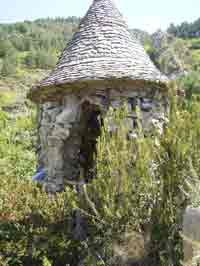Garden of La Font de la Magnèsia
In 1902, Gaudí visited the works of the chalet del Catllaràs, which he was constructing for the technical personnel of the coal mines, which were serving the factory Asland on Clot del Moro, near La Pobla de Lillet. One day, when Gaudí was in the chalet of Clot del Moro, there appeared a worker from the first textile factory on the course of the river Llobregat, in la Pobla de Lillet. The worker asked Gaudí if he could meet its owner, Joan Artigas i Alart. Joan Artigas had a very good relationship with Eusebi Güell and admired everything that Gaudí was doing in the Park Güell. In this way, he asked the architect for some ideas to place gardens in the area behind the factory, where the Llobregat river passed through. Gaudí promised that he would do this.
The spring of the following year, 1903, the architect travelled again to La Pobla de Lillet, to re-tackle the works of the chalet del Catllaràs. The work had been interrupted during the winter because of the severe weather. Gaudí also wanted to fulfil the promise that he had made to Joan Artigas. Artigas sent the tartan of the factory to collect Gaudí at Ripoll's railway station and lodged him in his house during Gaudí’s visit.
Gaudí, the architect of Nature, used its forms with franciscan humility. His intention was not to be a creator but simply an interpreter of the Creation, a modest continuer with the same laws. He was in front of a beautiful and wild landscape of high mountains, where the water of the Llobregat babbles noisily among the rocks and trees. He had learned to contemplate without prejudice or previous studies of the forms and colours of Nature, from a very young age. He knew that Nature is functional. Nature’s search for functionality leads to beauty, whereas looking only for beauty could fail due to aestheticism. His gardens, the biggest of which is the Park Güell –which was then in construction-, were not Renaissance, Baroque, English or of any other historical style, but natural. And if the Park Güell was a dry garden, this garden would be a humid garden marked by the Llobregat that flows through.
The clairvoyant and ingenious artist drew the sketches of a cave and two rustic bridges that ford the river. These sketches complete the architectural composition that the Great Architect had already made, the poetry, almost the musicality, of such a charming place. These sketches were destroyed, with a great part of the factory Artigas, by the Republican Army during their retreat in the Spanish Civil War (1936-1939).

To realize the ideas expressed in his drawings, Gaudí, on having returned to Barcelona, gave orders to employ a few experienced bricklayers of the Park Güell to initiate the work. They also trained the bricklayers of the factory Artigas in his constructive methods.
They were there for two months. An artificial cave was built with local unrefined stones in approximately six months. This cave protects the Font de la Magnèsia, the spring of medicinal water that gives the name to the garden. The cave measures 6 x 2 m. and has banks to sit down and two windows to view the Llobregat. Gaudí also sent plants from the Park Güell to be acclimatized to the high mountain: a palm, yuccas, etc. This is the only part of the gardens that Joan Artigas i Alart saw, because he died in December, 1903.
His inheritor, Joan Artigas i Casas, continued the construction of the garden, which was nearly fully completed in the autumn of 1906.
Following Gaudí's sketches, outside of the cave of the Font de la Magnèsia there is a rustic pergola, at the end of which is the fountain of the Lion. The path continues through an area of lawn that arrives at a balustrade further up the river. On the other side, a copse of pines shelters the fountain of the Ox. The bridge of the Magnesia crosses the river and the steps allow access to the sculpture of the Eagle. Another set of steps access the Summer-house. It is a pavilion of a circular floor and a conical cover. From the Summer-house you can see an excellent view of the river, of the garden and of the whole landscape. The itinerary continues up to crossing again the river over the bridge of the Arcs. At the entry of the bridge there are two plants pots, one in the shape of a man and another one in the shape of a woman. Taking this bridge, you can return to the back door of the factory.
All the rails, walls, arches, columns, etc. are made of rustic local stone supported on Portland assembled by iron. Also the three sculptures are made with rustic stone: the Ox, the Lion and the Eagle with unfolded wings. They never managed to put the fourth one, the Angel, which in Gaudí's sketches was placed in the centre of the waterfall. This could have completed the symbolism of that high mountain garden where Nature shows all its force: the four Christian gospels.
Some years after, Gaudí said to his disciples, to justify the structure of the basilica of La Sagrada Família, different from the registered ones in the books of Architecture and of the History of Art: The great opened book that is convenient to strain reading is the book of Nature. Other books come from this one and contain in addition the human mistakes and interpretations. He added: There are two revelations: the doctrinaire one of the Morality and of the Religion, and another one whom guides with the facts, which it is the great book of Nature.
The works lasted until 1910. It is possible that the architect visited it sometime again when he returned to La Pobla de Lillet.
All rights reserved
Last update: 06/05/2016